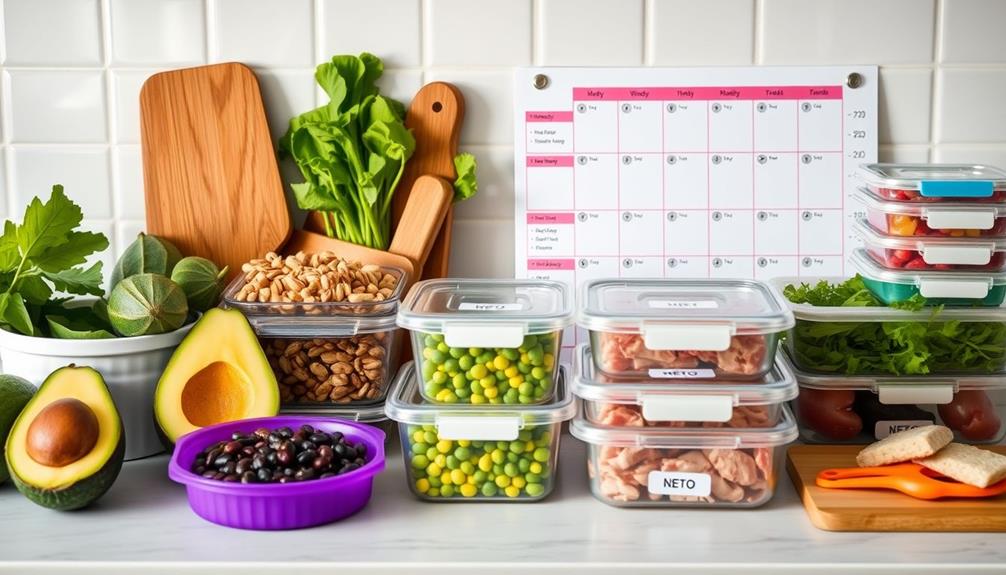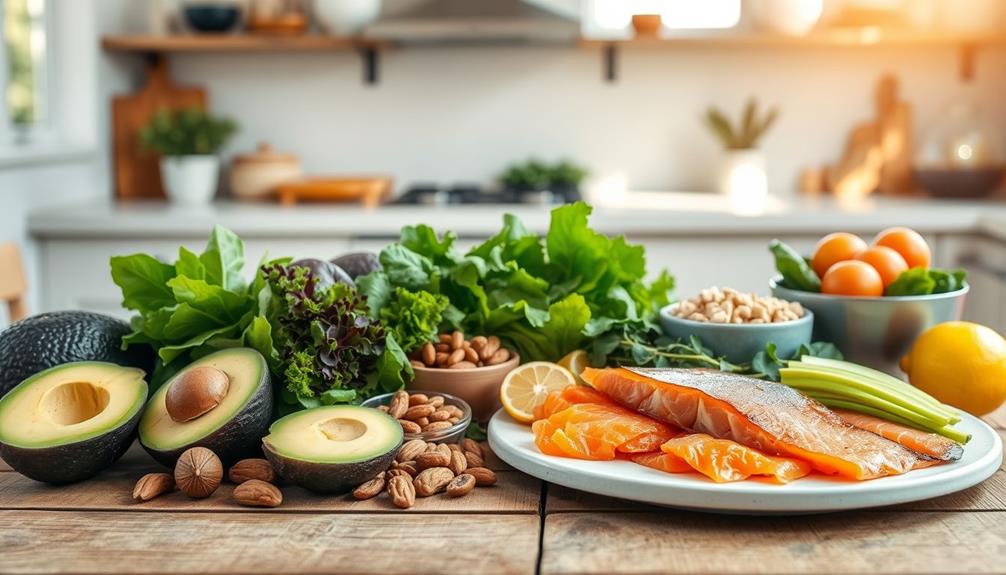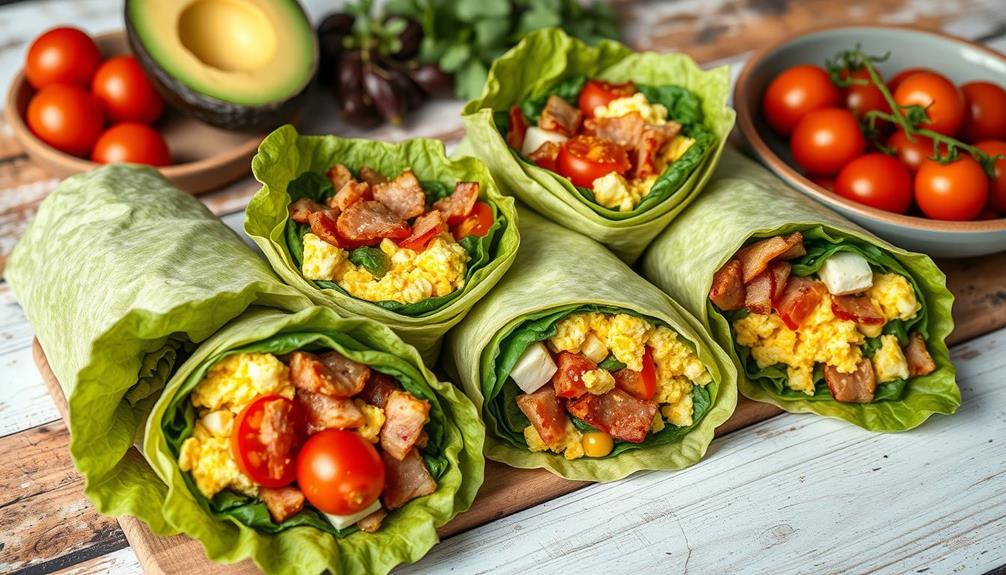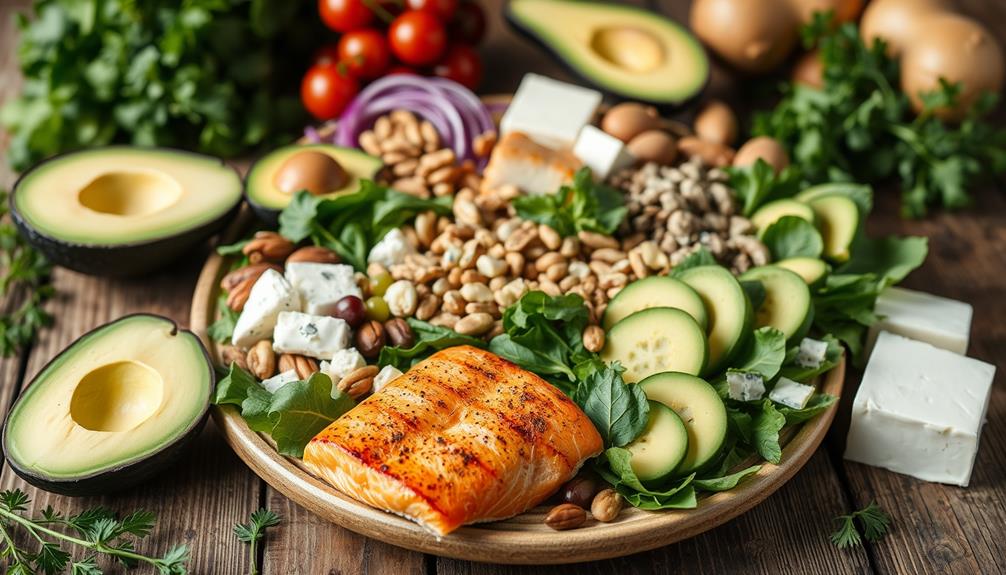Starting the keto diet is simpler than you might think. Begin by cutting carbs to 20-50 grams a day while filling your plate with healthy fats, like avocados and nuts, and moderate protein sources, like eggs and grass-fed meat. You'll want to avoid sugary foods, grains, and most fruits. Plan your meals to stay within your macronutrient limits, and don't forget to hydrate—this helps with "keto flu" symptoms. As you adapt, you may notice weight loss and improved energy. There's so much more to uncover about maintaining this lifestyle effectively, so keep exploring for tips and advice!
Key Takeaways
- Start by limiting carbohydrate intake to 20-50 grams daily to enter ketosis, focusing on a macronutrient ratio of 70% fats, 20% protein, and 10% carbs.
- Include high-fat foods like avocados, nuts, and olive oil, while incorporating healthy proteins and low-carb vegetables for nutrient density.
- Avoid sugary foods, grains, and most fruits, opting for low-carb options like berries to maintain ketosis.
- Plan meals weekly, utilize meal prep, and track food intake to ensure appropriate macronutrient balance and prevent calorie overload.
- Stay hydrated and increase electrolyte intake during the initial adjustment phase to manage "keto flu" symptoms effectively.
Understanding the Keto Diet

The Keto Diet is more than just a trendy eating plan; it's a structured approach that shifts your body into a state called ketosis. In this metabolic state, your body burns fat for fuel instead of carbohydrates.
To achieve ketosis, you typically need to limit your carbohydrate intake to 20-50 grams per day, prompting your liver to convert fats into ketones for energy. This high-fat diet generally comprises about 70% healthy fats, 20% protein, and only 10% carbs. Emphasizing healthy fats from sources like avocados, nuts, seeds, olive oil, and fatty fish is essential for success.
Many people turn to the keto diet for weight loss or to improve metabolic health, especially those with type 2 diabetes. Additionally, incorporating nutrient-rich foods can enhance your overall well-being while on this diet.
However, be prepared for the initial phase, as you may experience symptoms known as the "keto flu." This can include fatigue and headaches as your body adjusts to burning fat instead of carbs.
Foods to Include and Avoid

When starting the keto diet, knowing which foods to include and avoid is key to your success.
You'll want to stock up on high-fat options like avocados and fatty fish while steering clear of sugary snacks and grains.
It's also important to reflect on your overall health and well-being by incorporating effective strategies for weight loss as you commence this low-carb journey.
Let's explore the essentials that will help you thrive on this low-carb journey.
Essential Foods to Include
What essential foods should you incorporate into your keto diet? To successfully navigate your low carb diet, focus on high-fat foods that make up about 70% of your daily caloric intake.
It's also important to take into account potential side effects and interactions of certain foods, especially if you're using any cold medications while adjusting to this new diet, as they can affect your metabolism and overall health; for more information on dietary adjustments, refer to cold medications overview.
Here are three key categories to include in your meal plan:
- High-Fat Foods: Incorporate avocados, nuts, seeds, olive oil, and fatty fish. These foods not only provide healthy fats but also support your overall well-being.
- Healthy Proteins: Opt for grass-fed meat, poultry, eggs, and unprocessed dairy. Keep your protein consumption moderate to avoid gluconeogenesis, which can disrupt ketosis.
- Non-Starchy Vegetables: Fill your plate with spinach, kale, broccoli, and zucchini. These veggies are low in carbs and packed with essential nutrients, helping you stay within your carbohydrate intake limit.
Be cautious of hidden carbohydrates in processed foods and always check labels.
Foods to Avoid
Steering through the keto diet means knowing which foods to avoid to maintain ketosis and support your health.
First off, steer clear of sugary foods like soda, fruit juices, cakes, and candies. These are loaded with carbs and can easily hinder your journey to ketosis.
Eliminate grains such as wheat, rice, and pasta, which are significant carb sources; stick to a daily limit of 20-50 grams of carbs for effective keto adherence. Individuals with emotional dysregulation, such as those with Borderline Personality Disorder, may find it particularly challenging to adhere to strict dietary plans due to impulsive behaviors.
Most fruits should be avoided as well, except for low-carb options like berries—think strawberries and blackberries.
Additionally, watch out for starchy vegetables like potatoes, carrots, and corn, as these can spike your blood sugar levels and disrupt ketosis.
Focus on incorporating high-fat foods to meet your macronutrient ratio of about 70% fat, 20% protein, and 10% carbs.
Include items like avocados, nuts, seeds, olive oil, fatty fish, and unprocessed dairy products.
Snacks for Keto Success
To succeed on the keto diet, snacking wisely is vital for maintaining your energy levels and staying within your carb limits. Focus on high-fat, low-carb snacks that support ketosis while keeping you satisfied.
Understanding your investment goals can be just as important in achieving financial health as choosing the right snacks is for a keto diet. Here are three great options:
- Nuts and Seeds: Almonds, walnuts, and chia seeds are packed with healthy fats and protein, making them perfect for your ketogenic diet.
- Cheese and Olives: Both are rich in healthy fats and low in carbs, offering a delicious way to curb hunger.
- Berries: In moderation, strawberries and raspberries can be a great choice due to their lower carb content compared to other fruits.
Avoid snacks high in carbohydrates, like chips and cookies, as they can disrupt your ketosis and hinder your weight loss goals.
Keep portion sizes in check—even keto-friendly snacks can lead to calorie overload if consumed excessively. Incorporating options like hard-boiled eggs or beef jerky also guarantees you're getting protein and healthy fats without exceeding your carb limits.
Meal Planning Strategies

Effective meal planning is essential for success on the keto diet, as it helps you stay organized and committed to your goals. Start by creating a weekly meal plan that emphasizes high-fat foods like avocados, nuts, and fatty fish, while limiting carbohydrates to 20-30 grams per day.
Utilizing meal prep techniques, such as experimenting with flavors by incorporating unique spices and herbs, can enhance your meals and keep things interesting. Cooking large batches of keto-friendly recipes in advance guarantees you have convenient, ready-to-eat options available throughout the week.
Incorporate a variety of low-carb vegetables, such as spinach, broccoli, and cauliflower, to boost nutrient density while keeping your carbohydrate intake minimal. To achieve the right balance, track your intake by keeping a food diary or using an app. Aim for fat to comprise approximately 70% of your daily calories, with moderate protein and minimal carbohydrates.
Also, plan for social situations by researching restaurant menus in advance. Consider bringing your own keto-friendly snacks to avoid temptation and stay on track.
With these meal planning strategies, you'll find it easier to maintain your macronutrient intake and enjoy your keto journey effectively.
Health Benefits of Keto

With your meal planning strategies in place, it's time to explore the health benefits that come from adopting a keto lifestyle. Many people find that the ketogenic diet can greatly enhance their overall well-being. Here are three key benefits to evaluate:
Additionally, adopting a keto diet can be a strategic choice for your financial future, similar to investing in a Gold IRA as it promotes long-term health and wealth.
- Weight Loss: Studies show that participants on a keto diet lose about 2 pounds more than those on low-fat diets in the initial months. This might be just what you need to kickstart your weight loss journey.
- Improved Insulin Sensitivity: If you're dealing with type 2 diabetes, you'll be pleased to know that around 60% of participants see improvements in insulin sensitivity, with many even reversing their condition.
- Enhanced Mental Clarity and Energy Levels: The ketogenic diet fuels your brain with ketones, leading to sharper mental clarity and increased energy levels throughout the day.
Additionally, the keto diet can contribute to better heart health by improving cholesterol levels—reducing triglycerides and raising HDL cholesterol.
Managing Side Effects

Steering through the initial phase of a ketogenic diet can be challenging due to potential side effects, often referred to as "keto flu." You might experience fatigue, headaches, nausea, and irritability as your body adjusts to burning fat for fuel instead of carbohydrates.
To manage these symptoms, focus on maintaining adequate hydration and increasing your electrolyte intake, particularly sodium, potassium, and magnesium. These nutrients can help reduce fatigue and cramping, similar to how yoga for back pain emphasizes breath control to enhance relaxation and reduce tension.
Instead of drastically cutting your carbohydrate intake, try gradually reducing it over a week. This approach can ease the shift and minimize side effects. Incorporating high-fiber, low-carb vegetables like spinach or broccoli can also support digestive health, helping you avoid constipation and other digestive issues commonly associated with low-carb diets.
Don't forget to monitor your hydration levels. Consuming broth or electrolyte supplements can help prevent dizziness and cravings during the early stages of the ketogenic diet.
Long-Term Considerations

As you navigate the initial challenges of the ketogenic diet, it's important to think about what comes next. Shifting to a more balanced eating pattern after 3-6 months can help you avoid potential nutrient deficiencies and health risks.
Here are three key considerations for long-term success:
1. Monitor Health Markers: Regularly check your cholesterol and other health markers. Responses to a long-term keto diet can vary greatly among individuals, and monitoring guarantees you stay informed about your health.
Additionally, consider incorporating healthy dog snacks into your dog's diet, as they can promote overall wellness for your pets while you focus on your own health.
2. Incorporate Whole Foods: After the initial phase, focus on a wider variety of whole foods and balanced macronutrients. This shift can help maintain long-term weight loss while preventing weight regain.
3. Seek Support: Engage with healthcare professionals for continuous education about nutrition. Their support can enhance the sustainability of your dietary changes and help you navigate any challenges you face.
Resources for Beginners

Starting the ketogenic diet can feel overwhelming, but numerous resources are available to help simplify your journey. From medical-backed information to practical tips, you can find everything you need to get started on your keto diet plan.
Here's a quick overview of some resources that can guide you:
| Resource Type | Description |
|---|---|
| Medical Institutions | Cleveland Clinic and Mayo Clinic offer guidelines on the ketogenic diet, focusing on the health benefits and how your body burns fat for fuel. |
| Meal Plans | Johns Hopkins Medicine provides meal plans and tips tailored for managing a standard ketogenic diet (SKD) effectively. |
| Community Support | Online forums and support groups connect you with fellow beginners, sharing strategies and experiences that can motivate you. |
Additionally, websites and cookbooks filled with keto-friendly foods and recipes make it easier to stick to your meal plans while enjoying delicious meals. Remember, getting started on the ketogenic diet doesn't have to be intimidating—these resources will help you navigate smoothly and make the lifestyle change sustainable.
Frequently Asked Questions
How Do I Start My Keto Diet for the First Time?
To start your keto diet, lower your carb intake to 20-50 grams daily. Focus on high-fat foods, plan meals ahead, stay hydrated, and track your progress to guarantee you're meeting your dietary goals effectively. Keto diet benefits include weight loss, improved energy levels, and better blood sugar control. By following these initial steps and staying committed to your keto diet, you can experience these benefits and more. Remember to consult with a healthcare professional before starting any new diet or making significant changes to your eating habits.
What Is the Basic Rule of a Keto Diet?
Picture your body as a car, and the fuel's running low. The basic rule of a keto diet is to shift gears, cutting carbs to around 20-50 grams daily, igniting fat burning for energy.
What Is a Keto Diet Plan for Beginners?
A keto diet plan for you starts with cutting carbs to 20-50 grams daily while boosting fat intake to 70-80% of your calories. Focus on healthy fats, avoid sugars, and stay hydrated.
How Do Beginners Get Into Ketosis?
To get into ketosis, you'll need to cut carbs considerably, boost healthy fats, and maintain moderate protein intake. Staying hydrated and tracking your food will help you manage electrolytes and monitor your progress effectively.
Conclusion
As you commence your keto journey, think of it as a thrilling adventure where you're the hero, discovering new flavors and energy levels. By embracing this low-carb lifestyle, you're not just shedding pounds; you're igniting a vibrant transformation within. Remember, every meal is a stepping stone toward your goals. Stay curious, listen to your body, and don't hesitate to seek support. With each bite, you're crafting a healthier, more vibrant you. Let the journey begin!









